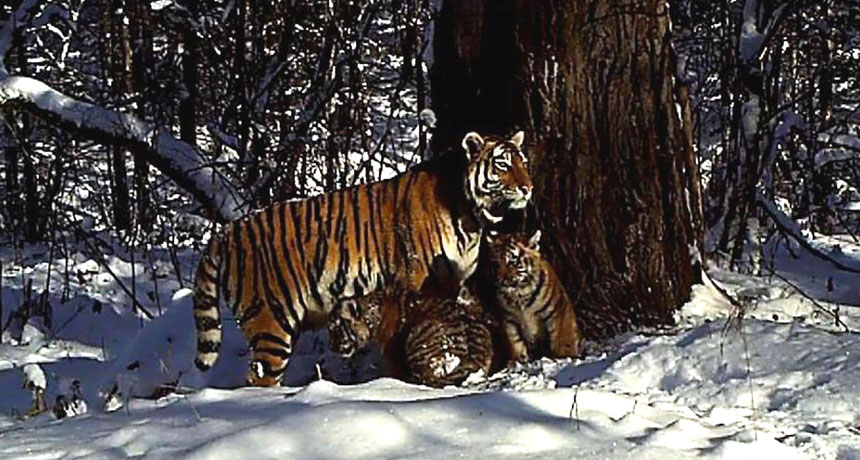Picture This: Rare tiger becomes mom
Zolushka is the first Amur tiger to be reintroduced to the wild and have cubs

A camera trap in the Bastak Reserve in Russia spotted Zolushka, the Siberian tiger, and her two cubs on December 9, 2015.
Bastak Reserve
A rare tiger has been spotted with two small cubs in the Bastak Reserve in far eastern Russia. Zolushka (which means “Cinderella” in Russian) is a Siberian (or Amur) tiger rescued as a cub. She is the first such rescue tiger to be released back into the wild and to then have cubs of her own.
“This is a watershed event not just for Zolushka, but for the entire population of Amur tigers,” said Dale Miquelle. He directs WCS Russia, one of the organizations that rescued the tiger. (WCS stands for Wildlife Conservation Society.) “These births mark the return of tigers to habitat that had been lost,” he said. Those cubs mark the “beginnings of a recovery and expansion of the last remaining Amur tiger population into habitat lost years ago.”
TIGER TIGER These videos of Zolushka and her cubs were captured by a camera trap in the Bastak Reserve in Russia. Anton Semyonov |
WCS released the camera trap image. The society knows that it shows Zolushka for three reasons, says Jonathan Slaght. He is projects manager of the WCS Russia Program. “The most apparent way to know this is Zolushka is by her short tail,” he says. “She lost the tip to her tail to frostbite as a small, orphaned cub.” Second, the Bastak Reserve hosts only one adult female tiger: Zolushka. “So, right now anyway, any photo of an adult tigress in Bastak is of Zolushka,” he says. But most compellingly, he notes, each tiger wears a unique set of stripes. “So we are certain this is Zolushka,” Slaght says.
This tiger was found in a remote part of Russia in February 2012. Only four months old at the time, she was lying in the snow. She had not eaten for days. The tip of her tail was black with frostbite when Miquelle and other tiger specialists rescued her. She was raised away from humans, so she wouldn’t get too comfortable around them. And her keepers gave her live animals to eat, so she would know how to hunt. Then in May 2013, when she was about 20 months old, Zolushka was released into the Bastak Reserve.
In the late 19th century, Amur tigers roamed across a large swath of eastern Russia, China and the Korean peninsula. But hunting and habitat destruction has cut their range and numbers. The latest Amur tiger census calculates that there may be no more than 540 animals in the wild. That is a low number. But it is more than the 420 Amur tigers that existed a decade ago.
Conservation groups are working to further increase the number of these tigers in the wild. Zalushka is part of that work. So far, six tigers have been rescued and released back into the wild. Only one didn’t adapt well. He now lives in a Russian zoo. Zolushka is the first, though, to reproduce.
Before Zolushka, there had been no tigers seen in the Bastak Reserve for 40 years. Shortly after she arrived, though, a lone male showed up. He had probably traveled some 200 kilometers (120 miles) from the northernmost portion of the Amur tiger’s range in Russia to get there. It is thought that he must have fathered the two cubs.
“These cubs are about three to four months old,” says Slaght. “Young tigers typically stay with their mother until they are about a year and a half old, at which time they disperse to find their own territories.”
Power Words
(for more about Power Words, click here)
camera trap A still or video camera set to activate when motion is detected. The device is often used to monitor wildlife. But it can also be used to find poachers.
conservation The act of preserving or protecting something. The focus of this work can range from art objects to endangered species and other aspects of the natural environment.
disperse To spread, often widely. Plants, for example, disperse their seeds to far off sites by allowing them to ride the winds or survive being eaten by animals that travel great distances.
frostbite Damage caused to skin and other tissue when it freezes.
habitat The area or natural environment in which an animal or plant normally lives, such as a desert, coral reef or freshwater lake. A habitat can be home to thousands of different species.
population (in biology) A group of individuals from the same species that lives in the same area.
range The full extent or distribution of something. For instance, a plant or animal’s range is the area over which it naturally exists.







